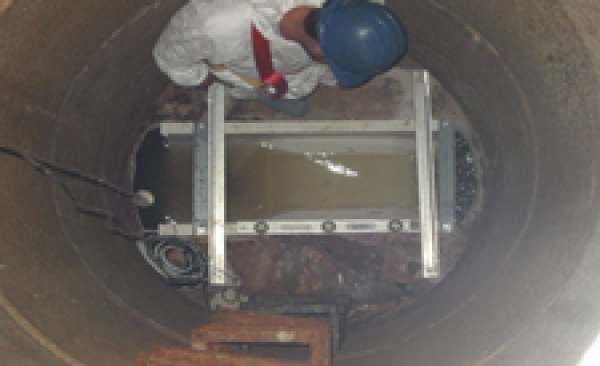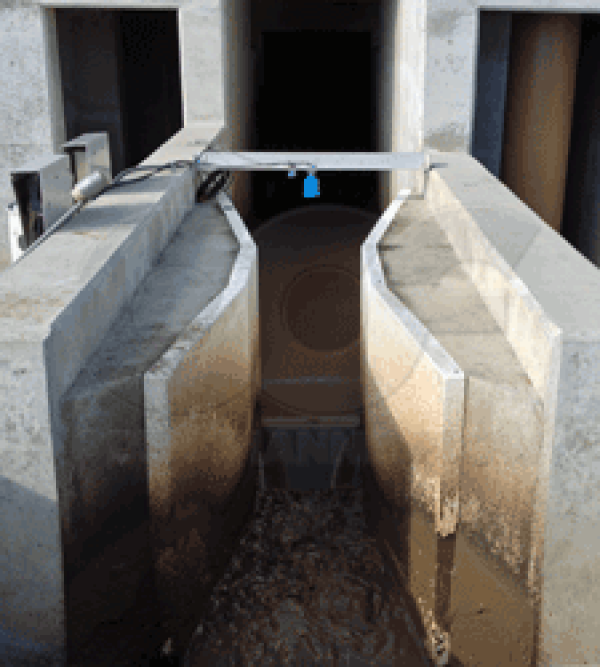This website uses a variety of cookies, which you consent to if you continue to use this site. You can read our Privacy Policy for
details about how these cookies are used, and to grant or withdraw your consent for certain types of cookies.
Fiberglass Parshall Flumes at Wastewater Plants
Fiberglass Parshall Flumes are the standard for measuring influent and effluent flows at wastewater treatment plants (WWTPs) in North America. Widely used in surface water / irrigation applications, the Parshall flume adapts well to sanitary applications while fiberglass resists the corrosive effects of raw sanitary sewage and provides a level of dimensional accuracy that is difficult to match.
Fiberglass Parshall flumes can be found throughout wastewater treatment plants measuring influent, effluent, and equalization flows.
Influent Flows / Headworks
The environment at a treatment plant headworks is particularly abusive for equipment. The flow is corrosive (primarily due to hydrogen sulfide) and may contain high levels of grit.
For a flume, these two factors rule out most materials of construction: galvanized steel would corrode to quickly and concrete is prone to biogenic / Microbial Induced Concrete Corrosion (MICC). Fiberglass backed polypropylene – used primarily in Europe – is almost unheard of in North America and does not posses the same surface toughness or strength as the isophthalic polyester resins used in premium fiberglass constructed flumes.
The only alternative to fiberglass, then, is to construct the flume out of stainless steel. Stainless steel, however, is costly, heavy, and not available in mass-produced volumes. Additionally, to exhibit the same level of corrosion resistance as iso-fiberglass, the flume would need to be constructed from 316 grade stainless – which is even more costly than the already expensive 304 grade.
The smooth gel coated flow surfaces of fiberglass flume are easy to clean and maintain and resist the build up of solids and biological growths. Typically the only maintenance that is required is occasionally scrubbing of any buildup of scum on the staff gauge and sidewalls of the flume.
With fiberglass as the preferred material of construction for flumes in general at a treatment plant headworks, the question then becomes: why the Parshall flume?

As we mentioned earlier, Parshall flumes have proven themselves to be well adapted to the types and ranges of flows that one commonly sees at a plant.
Available in 20 sizes suitable for use on sanitary flows* – from 3-inches to 144-inches - the Parshall flume can be used on small treatment lagoons, packaged plants, and all the way up to large metropolitan facilities. More sizes of flumes are available in the Parshall style than any other flume type.
Also, the Parshall flume is unaffected by the high levels of suspended solids found in influent flows. The flume is self-cleaning with a flat inlet floor and a drop through the throat that accelerates the flow in such a way as to keep the floor of the flume scoured clean of sediments and debris.
This contrasts with the Palmer Bowlus flume, which relies on an elevated ramp to develop the proper flow characteristics through the flume. On high solids flows, the ramp of the Palmer Bowlus flume can result in sediments collecting upstream of the ramp – particularly if the solids are heavy (like grit) or the flows periodically drop (like at night).
Parshall flumes can be installed in channels – the usually method for larger treatment plants – or connected to piping though the use of end adapters - common in smaller or packaged plants.
Finally, with the widespread us of the Parshall flume comes a level of operator familiarity. It is easy to read the level in the flume, requires minimal maintenance, and is preprogrammed into almost all open channel flow meters.
Effluent Flows
From a fabrication standpoint, once a fiberglass master mold has been produced and its dimensional accuracies checked, assuming good production techniques and materials are used, fiberglass flumes exhibit excellent dimensional accuracy and, importantly, repeatability.
In stainless, concrete, or any one-off construction, the likelihood that fabrication errors relating to dimensional accuracy will occur increase with each unit produced – much more so than with molded fiberglass construction.
This is not to say that other materials of construction do not have a place for flumes in general and Parshall flumes in particular, simply that given the combination of relatively low cost, high strength, and excellent dimensional accuracy of fiberglass, the case simply doesn’t support other materials for most wastewater applications.

Fiberglass flumes can exhibit great dimensional accuracy. In the critical throat section, dimensional tolerances of Parshall flumes 12-inches or less in size of +/-1/16-inch [0.1588 cm] are to be expected from quality flume manufacturers – a deviation of only 2.08% to 0.53% of the nominal dimension Parshall flumes from 3-inches to 12-inches in size (the percentage of deviation decreasing as the flume gets larger).
This dimensional accuracy is important when determining the effluent from a treatment plant as the amount a plant is allowed to discharge is strictly limited by the plant’s NPDES (National Pollutant Discharge Elimination System) permit. The NPDES permit program controls water pollution by:
“…regulating point sources that discharge pollutants into water of the United States”
All municipal, industrial, and other facilities must obtain NPDES permits if their discharges go directly into surface waters.
In fact the EPA has developed inspection guidelines for treatment plants specifically using Parshall flumes to measure the influent and effluent flows. They have even gone so far as to develop a video on the implementation of the inspection guidelines.
Equalization / Interplant Flows
Many of the characteristics that serve both the Parshall flume and fiberglass construction so well at the headworks of a treatment plant, are also beneficial as flow moves through the various stages of treatment on its journey through the plant.
Fiberglass construction is unaffected by untreated (or partially treated) sanitary sewage and build-up in the Parshall flume is minimal.

As the flow is treated and process streams are diverted off, or later recombined, the variety of sizes available for in the Parshall flume means that flumes can be tailored to the individual flow steam. By using one type of flume throughout a plant, the burden on the operator is eased as reading / using a flume at one portion of the plant is the same as at another portion of the plant. The benefits of commonality cannot be overstated.
*It is important to note that when using a Parshall flume to monitor headworks flows, the 3-inch size is the smallest Parshall flume that should be used. Use of the 1-inch or 2-inch sizes on unscreened sanitary flows will resulting in clogging, even if they better fit the anticipated flow rates.
Source: US Environmental Protection Agency – National Pollution Discharge Elimination System
Related Blog Posts
Explore more insights in our blog.

LOCATIONS IN ATLANTA, GA & BOISE, ID





